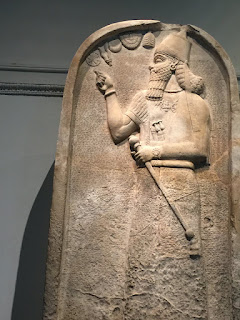Today, storyboard connotes is a series of illustrations or key points illustrating the concept for a film or TV program. Like many techniques from the screenwriting world, this method is also wonderfully useful for novelists and so popular that you’ll find numerous online options for help. But the basic idea is actually much older. Much, much, much older.
Illiteracy, thankfully now far less widespread, was once the norm. If you wanted people to understand the story, you had to show it. Only pictures would do.
For example, in one of the oldest storyboards, the palace of the Neo-Assyrian King Ashurnasirpal II (883-859 BC) at Nimrud (now in northern Iraq) had larger-than-life slabs depicting royal and religious ritual. In the photos below, a winged god drops offers pollen from the scared tree of life, insuring the fertility of the land and its people.
Though novelists use words, the storyboard can give the author an equally useful visual. As Candace Williams observes in “Storyboarding for Novelists,”
Storyboarding is not a rigid plotting device. The whole point of the board is that it’s flexible. The greatest advantage is seeing exactly how your novel is “built,” just as an architect refers to a blueprint.
The storyboard is especially useful to these novelists:
~ Plotters and pantsers.
If you’re a plotter, this lets you assess pivot points even more efficiently. If you’re a pantser, a storyboard lets you see where you’re going with the least restriction possible.
~ Internal world addicts. Do you revel in oodles of talking and thinking and more of the same?
Provide an image for each scene, and something will happen in the physical world.
~ Nonlinear writers.
a storyboard, you can write the fourth scene, sixteenth, then second and so on. Compose in any order you like and still see where you are.
In an interview, Rebecca Skloot, author of the complex and successful The Immortal Life of Henrietta Lacks, addressed the complexity of her creative nonfiction with index cards.
Chuck Sambuchino, in “Storyboarding For Success: Plotters vs. Pantsers,” reminds that:
The magic of a storyboard is turning a book idea into a visual tool, which makes the story’s structure much easier to grasp and handle. A storyboard can be drawn on a board, a piece of paper, or in a computer file.
The storyboard reveals where the climax is, and, in fact, whether you have a climax at all! The inciting incident and major moments that earn the ending are visible—and thus readily reparable. Use index cards, sticky notes, sheets of paper, an Excel spreadsheet, or the many free apps and templates.
Tip: Storyboarding’s been around for a long, long time. With good reason.




No comments:
Post a Comment
Note: Only a member of this blog may post a comment.